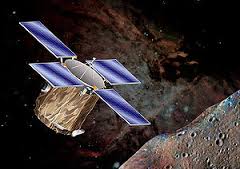The research spacecraft "Nir" approached and then landed on the surface of the asteroid, providing for the first time close-up photographs of a world 300 million km away from us

Dr. Noah Brosh
On February 12, the "Nir" spacecraft landed on the asteroid Eros - an unplanned landing that yielded incredible success and a series of new discoveries. Among other things, "sand lakes" were found. But about the origin of the sand and gravel (probably particles smaller than 1 cm) and how it sticks to a tiny body in space like the asteroid Eros - there are only conjectures at this stage.
"Nir" was designed to study an asteroid - a tiny body that orbits the Sun and sometimes approaches the Earth. The scientists wanted to learn about these bodies that might collide with the Earth. For this purpose, the asteroid "Eros" - an elongated body measuring 34x13x13 km - was designated as the target. "Nir" reached it and entered orbit around it to map its surface and measure other properties (mass distribution, magnetic fields, etc.).
At the beginning of the mapping work, "Nir" was found in a trajectory of about 100-200 km from "Eros", but towards the end of this part of the operation, its trajectory was lowered and it dropped to a few kilometers, from its surface. Then close-up photographs of strange details were also taken, which look like "lakes" - very smooth sections on the surface of the ground that look like bodies of water.
There is no doubt that there is no water in liquid form on the surface of Eros. If there were - they would evaporate immediately due to the low pressure. With the end of the orbital mapping operation, it became clear that there is a possibility to land "Nir" on the asteroid, by activating the braking engines with the remaining fuel left in the spacecraft. Five times the engines were activated - and thus "Nir" approached the surface of Eros at a speed of about 2 meters per second (as in falling from a height of 40 cm on the Earth).
The spacecraft transmitted photographs of Eros during the descent to his face. The process lasted about four and a half hours. Each photo is 15 milliseconds long and every 45-20 seconds, a new photo is transmitted to Earth. The latter - captured here only in part - was taken from a height of 129 meters from the asteroid and shows details of 1 cm in size.
The most impressive is the seventh event, the spacecraft was at a distance greater than 300 million km from the country - and the transmission was on its way to us, at the speed of light, for more than 17 minutes. The close-up of Eros' face shows significant differences from place to place in the photo. The series of photographs showed a field rich in stone fragments and a smooth surface, and without craters.
The researchers who examined the photographs believe that most of the visible details are probably the result of another body hitting Eros - an event that created a crater with a diameter of 7.6 km at its end. During this impact, blocks of rock were thrown into the distance at different speeds. Some of them bounced back and fell on the surface of the asteroid. The sand and gravel that accumulated in the various "lakes" was probably created by this impact - and perhaps by other impacts as well.
Fine sand may "absorb" an electric charge, if the grains are in a space without an atmosphere, and are illuminated by the sun's ultraviolet radiation. Under the influence of the electric charge, these particles can float and accumulate in places where the electric charge is reversed. This is, perhaps, the mechanism that created the sand lakes on the asteroid.
